CD measures the difference in absorption between left and right handed circularly polarized light of chiral samples. CD is an established biophysical method used to study folding of peptides, proteins, oligo-nucleotides and DNA which have distinct CD bands in the far-UV and VUV. Secondary structure can be determined and changes followed with e.g. ligand binding, temperature, salinity etc.
What are the sample requirements?
- The protein concentration required is inversely proportional to the cuvette pathlength, and thus a 1 mm path cuvette requires 10x the concentration of a 10 mm cuvette.
- Typical concentrations of samples required are: 1 mg/ml for 0.1 mm pathlength, 1 mg/ml for 1 mm pathlength, 10 mg/ml for 10 mm pathlength
with alpha-helical proteins possibly needing ~half this concentration, while predominantly beta-sheet may require double this concentration. If possible, make a concentrated stock solution of your protein (at least 2x) and dilute as needed. - Load volumes are typically 30-150 uL for 0.1 mm pathlength, 350-500 uL for 1 mm and 3 mL for a 10 mm pathlength cell (these depend on the type of cell available and whether a temperature melt is being measured).
- Many commonly used buffers (Tris, HEPES, MOPS) and additives absorb in the far UV region used for CD measurements. The ideal CD experiment is performed in a buffer in which your protein is well behaved and soluble with little to no buffer absorbance through the range of the CD spectrum. The optimum buffer is a phosphate buffer, pH adjusted using a mixture of the mono and divalent Na+ forms, with ionic strength adjusted using NaF instead of NaCl.
What other specific considerations are relevant?
- Protein aggregates can interfere with the CD signal. It may be necessary to assess protein heterogeneity via light scattering and purify protein samples with soluble aggregates by size-exclusion chromatography.
- Measurement of protein aggregates or highly scattering samples may be possible, for samples of this kind you can contact AU-SRCD.
- For determination of secondary structure, an accurate measurement of concentration of the protein/peptide is needed.
Partners offering this technique
MOSBRI reference partner site for this technique:
Other partners:
